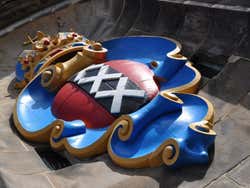
Curious facts about Amsterdam
Amsterdam is a one-of-a-kind city full of curious elements that will surely draw your attention. This article tries to answer some of the most puzzling ones.
Crooked houses and pullies
When Amsterdam began to expand, the land was very expensive, so the inhabitants bought small plots of land and built long and narrow houses with cramped staircases, making it impossible to fit large furniture up the steps.
To solve this problem, the architects designed large windows and placed a pulley at the top of the house to lift the furniture and pull it through the door.
You will notice that the houses not only lean to one side, but also forward. It is believed that the latter is because it is easier to get the furniture up that way.
As you walk along the canals, look up at the houses and you will see the wooden pullies.
The three X (XXX)
Amsterdam is full of symbols, one of the most famous is the three "X", which is even painted on the city's flag. Even though this symbol is painted throughout the capital, Amsterdamers are not sure what it stands for.
There are various theories, one of the most popular is that the “X” symbolizes the crucifixion of Andrew the Apostle.
Other more romantic version states that the three “X” represents courage, determination and clemency, the three adjectives Wilhelmina of the Netherlands used to describe the city.
The last speculation is that the three “X” symbolizes the various disasters that hit the city throughout the centuries: fires, plague and flooding.
Los Hofjes
Since the Middle Ages, there has always been a strong tradition among the citizens of Amsterdam and the Netherlands to help those in need. In the beginning, the church was made responsible for the poor; however, in the fourteenth century the city’s municipal authorities took over distributing food and creating institutions to help protect the most vulnerable.
In Dutch, a hofje was a privately funded courtyard with a poorhouse around it that welcomed the elderly, especially women, who could no longer work.
One of the best preserved and most-visited hofjes in Amsterdam is Begijnhof.
You can also visit beautiful courtyards of other hofjes like Zon and de Star. They are very close to each other, so you can see them on the same day (Prinsengracht Street), close to Anne Frank’s House.


